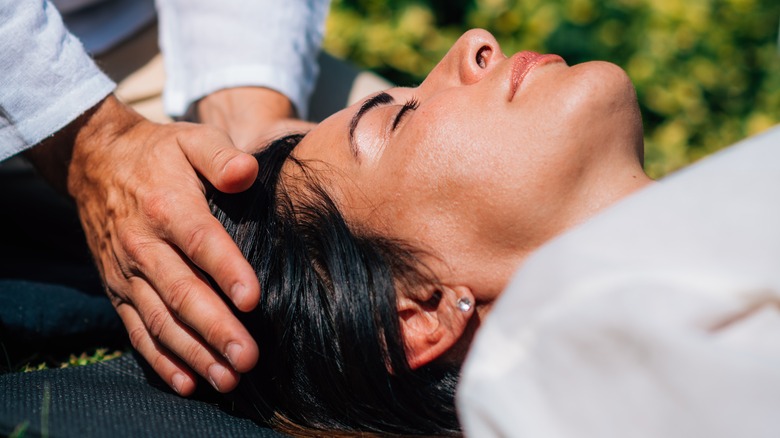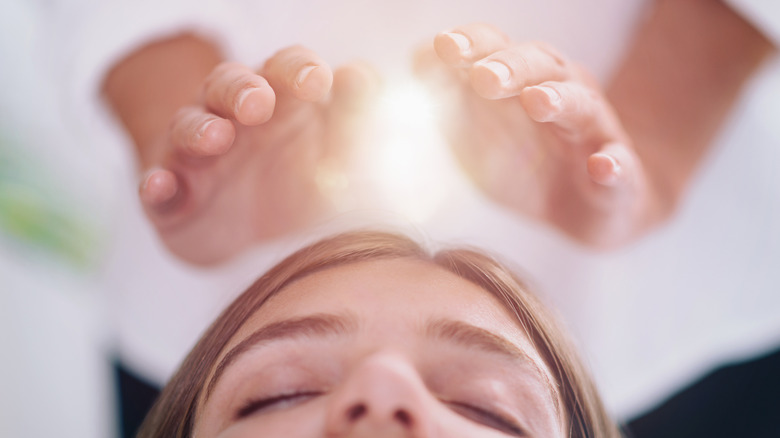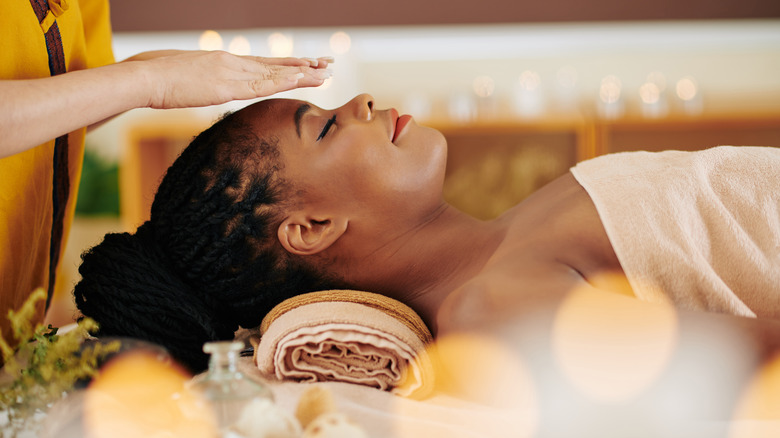What To Know Before Starting Reiki
With self-care on the rise, energy healing is becoming just as mainstream as buying beauty products, and Gen Z and millennials are becoming as dedicated to their internal glow-up as to the external. As we continue to push past outdated ideas of toxic productivity and capitalistic consumption, more people are looking to the unseen for emotional healing and spiritual development. One such practice that's growing in popularity is reiki, the Japanese practice of balancing energetic forces in the body (via MindBodyGreen). According to Yahoo, some professional athletes bring practitioners with them on the road. And the #reiki hashtag is booming with over 1 billion uses on TikTok, where practitioners virtually send energetic healing to users at home.
If you've never gone to an energy worker or dived into the world of spiritual healing, you may be suspicious about whether or not it actually works. That's hard to say definitively, but much of the unseen energetic world is still a vast mystery. For instance, you may be shocked to know that humans can only see less than 1% of the entire light spectrum — about 0.0035%, to be exact (via the U.S. Department of Energy). Reiki is the gentle art of working with the unseen, and if you're interested in trying out its benefits, it's going to take your trust. Here's what you should know before getting started.
Reiki works with your life force
To some, it may seem "new-agey" or "woo-woo," but reiki has paved a fundamental lane in alternative medicine. Centered around understanding the flow of energy throughout our bodies, it is practiced in hospitals, private practice, and medical centers (via the International Association of Reiki Professionals). The technique involves a practitioner who is attuned to working with the body's life force, or "ki." They channel this life force through their hands by placing their palms on or over the patient's body, allowing energy to flow between them (via Cleveland Clinic). This creates an incredibly relaxing and almost ethereal experience.
Though reiki can be used to alleviate physical pain and injuries, it is becoming more widely known for its balancing of the seven chakras. The chakras, which may be familiar to proponents of Eastern medicine, are said to be energy centers that lie along the spine from the top of the head to the bottom of the feet, which may be prone to energetic or emotional blockages (via MindBodyGreen). After using reiki to restore energy balance within their bodies, practitioners say that many people report feeling more relaxed or energized (via Forbes).
Reiki may reduce pain, anxiety, and depression
Going to a reiki session is reminiscent of getting a massage. You can expect to enter a cozy, comfortable room with warm low lights, a welcoming presence, and maybe a few Himalayan salt lamps. Though you'll need to lie on a massage table, removing clothes is not necessary. Think of it as entering a delicate safe space that seeks to recalibrate the body through deep relaxation. Even though your reiki practitioner will have access to your etheric body, the process is non-invasive, calming, and blissfully mellowed out.
Due to reiki's spiritual nature, there is much skepticism about the practice. Many people believe that the positive effects of reiki stem from human comfort and calming surroundings rather than actual energetic manipulation (via Forbes). One 2016 study found, however, that when reiki was used repeatedly for eight weeks, participants experienced marked differences in depression compared to the placebo counterpart. That isn't to say that reiki is an end-all-be-all to physical or emotional pain. As Reiki Master Victoria Bodner tells Cleveland Clinic, "Reiki complements other types of medical and therapeutic treatments, and it can increase the efficacy of other types of healing." In short, if you're dealing with specific medical issues, reiki should be used to enhance mainstream treatments, not to replace them.


